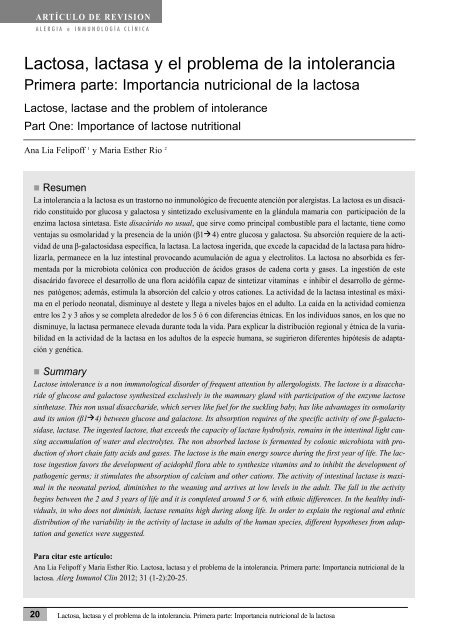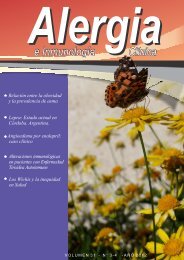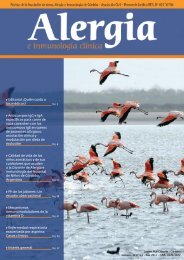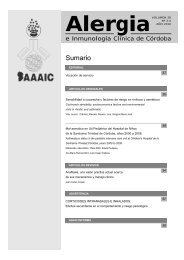VOLUMEN 31 Nº 1-2 año 2012 - cordobalergia.com
VOLUMEN 31 Nº 1-2 año 2012 - cordobalergia.com
VOLUMEN 31 Nº 1-2 año 2012 - cordobalergia.com
Create successful ePaper yourself
Turn your PDF publications into a flip-book with our unique Google optimized e-Paper software.
ARTÍCULO DE REVISION<br />
A L E R G I A e I N M U N O L O G Í A C L Í N I C A<br />
Lactosa, lactasa y el problema de la intolerancia<br />
Primera parte: Importancia nutricional de la lactosa<br />
Lactose, lactase and the problem of intolerance<br />
Part One: Importance of lactose nutritional<br />
Ana Lia Felipoff 1 y Maria Esther Rio 2<br />
Resumen<br />
La intolerancia a la lactosa es un trastorno no inmunológico de frecuente atención por alergistas. La lactosa es un disacárido<br />
constituido por glucosa y galactosa y sintetizado exclusivamente en la glándula mamaria con participación de la<br />
enzima lactosa sintetasa. Este disacárido no usual, que sirve <strong>com</strong>o principal <strong>com</strong>bustible para el lactante, tiene <strong>com</strong>o<br />
ventajas su osmolaridad y la presencia de la unión (β1 4) entre glucosa y galactosa. Su absorción requiere de la actividad<br />
de una β-galactosidasa específica, la lactasa. La lactosa ingerida, que excede la capacidad de la lactasa para hidrolizarla,<br />
permanece en la luz intestinal provocando acumulación de agua y electrolitos. La lactosa no absorbida es fermentada<br />
por la microbiota colónica con producción de ácidos grasos de cadena corta y gases. La ingestión de este<br />
disacárido favorece el desarrollo de una flora acidófila capaz de sintetizar vitaminas e inhibir el desarrollo de gérmenes<br />
patógenos; además, estimula la absorción del calcio y otros cationes. La actividad de la lactasa intestinal es máxima<br />
en el período neonatal, disminuye al destete y llega a niveles bajos en el adulto. La caída en la actividad <strong>com</strong>ienza<br />
entre los 2 y 3 años y se <strong>com</strong>pleta alrededor de los 5 ó 6 con diferencias étnicas. En los individuos sanos, en los que no<br />
disminuye, la lactasa permanece elevada durante toda la vida. Para explicar la distribución regional y étnica de la variabilidad<br />
en la actividad de la lactasa en los adultos de la especie humana, se sugirieron diferentes hipótesis de adaptación<br />
y genética.<br />
Summary<br />
Lactose intolerance is a non immunological disorder of frequent attention by allergologists. The lactose is a disaccharide<br />
of glucose and galactose synthesized exclusively in the mammary gland with participation of the enzyme lactose<br />
sinthetase. This non usual disaccharide, which serves like fuel for the suckling baby, has like advantages its osmolarity<br />
and its union (β1 4) between glucose and galactose. Its absorption requires of the specific activity of one β-galactosidase,<br />
lactase. The ingested lactose, that exceeds the capacity of lactase hydrolysis, remains in the intestinal light causing<br />
accumulation of water and electrolytes. The non absorbed lactose is fermented by colonic microbiota with production<br />
of short chain fatty acids and gases. The lactose is the main energy source during the first year of life. The lactose<br />
ingestion favors the development of acidophil flora able to synthesize vitamins and to inhibit the development of<br />
pathogenic germs; it stimulates the absorption of calcium and other cations. The activity of intestinal lactase is maximal<br />
in the neonatal period, diminishes to the weaning and arrives at low levels in the adult. The fall in the activity<br />
begins between the 2 and 3 years of life and it is <strong>com</strong>pleted around 5 or 6, with ethnic differences. In the healthy individuals,<br />
in who does not diminish, lactase remains high during along life. In order to explain the regional and ethnic<br />
distribution of the variability in the activity of lactase in adults of the human species, different hypotheses from adaptation<br />
and genetics were suggested.<br />
Para citar este artículo:<br />
Ana Lia Felipoff y Maria Esther Rio. Lactosa, lactasa y el problema de la intolerancia. Primera parte: Importancia nutricional de la<br />
lactosa. Alerg Inmunol Clin <strong>2012</strong>; <strong>31</strong> (1-2):20-25.<br />
20<br />
Lactosa, lactasa y el problema de la intolerancia. Primera parte: Importancia nutricional de la lactosa






